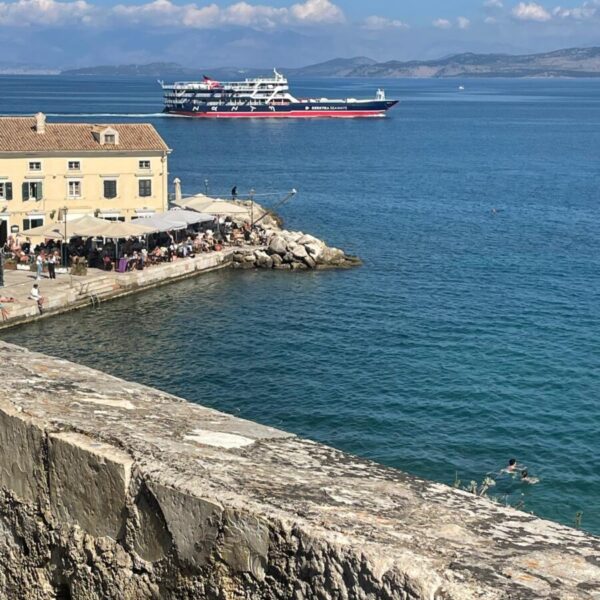The reality of Corfu today is that it is an island overwhelmed, if not invaded, by overtourism in the Mediterranean. It is difficult to find one’s place as a walker, or better yet, as a traveler seeking the unexpected, a certain taste of elsewhere, and the pleasure of being amazed, if not surprised. There remains the possibility of taking alternative paths, starting with that of literature and writers.
On the promenade of the old town of Corfu, the most frequented by visitors, where one can glimpse not far away the floating buildings that are the large cruise ships, there is a house, facing the sea, which is very little visited. Yet it embodies one of the constants or foundations of contemporary Greece, this nation reinvented in the 19th century. It is the house/museum of the poet Dyonisos Solomos. The last residence of the bard of modern Greece, author of the famous “Hymn to Freedom,” which inspires and expresses the national anthem of an independent Greece.

Emerging from among the bones
Of the Hellenes — sacred bones,
And valiant as before
Hail, oh hail, freedom!
The world passes below, in an incessant flow, on Arseniou street, while he remains, in this house that brushes against the Ionian Sea, where he resided between 1832 and 1857. Originally from the island of Zante, educated in Italy, the language of his early literary texts, Solomos is the voice of the Greek being. Not in a pure language that he rejects, as it forgets or despises the popular dialects, no, it is in a language that carries a breath, the deep desire to reconnect with what came from ancient Greece, without ever freezing it in a mythical model that no longer exists. This “Hymn to Freedom,” written by Solomos and composed by Nikolaos Chalikiopoulos Mantzaros, can currently be discovered in manuscript form at the Municipal Gallery of Corfu, located in a suspended garden, facing the Venetian citadel that dominates the old town.
Thus, in the heart of Corfu, visited by a multitude of tourists equipped with phones snapping countless selfies, Solomos watches with a benevolent and attentive eye over what constitutes the permanence of a Nation. His language, his literature, and his song trace as many symbols—symbolon—literally, that which holds together. His poetry composes and expresses something like a proper, the vibrant place of a word in the City, which establishes or creates a We, in the Greek way. To give an example and attempt a comparison, it would be somewhat like for a French person the poetry of Victor Hugo, or “Liberty Leading the People,” that iconic painting by Delacroix which gives us the image, icon, or symbol of the Republic. This is undoubtedly what Solomos embodies in the history of contemporary Greece.
He is right there, in Corfu, on Arseniou street; one just needs to take a step aside and make a small stop in his house, to come visit him and better realize what he represents.
Georges Séféris, another immense Greek poet, has not been mistaken about this. In the lecture he gave at the Swedish Academy on December 11, 1963, on the occasion of receiving his Nobel Prize in Literature, he emphasizes how the poet born on the island of Zante carried what he calls the “demon of the absolute” and he specifies:
“Solomos is undoubtedly the author of ‘The Hymn to Freedom,’ whose first verses constitute our national anthem, and other poems that have been set to music and sung abundantly throughout the last century. Yet it is not because of this that his legacy matters to us; it is because he was able to trace, in a way as definitive as his time allowed, the path that Greek expression should take. [1]”
Why not follow these alternative paths in Corfu? Meet one of the fathers of contemporary Greek poetry and literature, and subvert the clichés or preconceived ideas that clutter the view of the Greek world and this island of immense beauty. There are still wild places, unpaved, on this great Ionian island, that offer themselves to curious visitors. And other alternative paths, such as this ferry ride to just next door, to Albania, in the small port town of Sarandë. Another world so close, at the end of this parallel Mediterranean formed by the Adriatic...
[1] Georges Séféris, Some Points of Modern Greek Tradition, AIORA Editions, bilingual, 2016, p 31

Photo credit: Thierry Fabre
